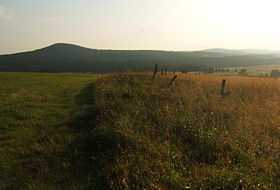Božídarský Špičák
| Božídarský Špičák | |
|---|---|
 The Gottesgaber Spitzberg at dusk | |
| Elevation | 1,115 m n.m. (3,658 ft) |
| Location | |
 Božídarský Špičák | |
| Range | Ore Mountains |
| Coordinates | 50°24′11″N 12°53′14″E / 50.40306°N 12.88722°ECoordinates: 50°24′11″N 12°53′14″E / 50.40306°N 12.88722°E |
| Geology | |
| Type | nephelin basalt |
| Climbing | |
| Access | ca. 1895 by an observation platform (Aussichtsgerüst) |
The Božídarský Špičák (German: Gottesgaber Spitzberg) is the third highest mountain in the Ore Mountains. It lies in the Czech Republic immediately next to the highest town in Centra Europe, Boží Dar (Gottesgab).
Location and surrounding area
The Špičák or Spitzberg lies two kilometres southwest of Boží Dar on the plateau of the Ore Mountains in a strict nature reserve. For nature conservation reasons its summit is not open to the public. At the western foot of the summit there is an observation point near the ruins of the Spitzberghäuser, including those of the inn, Zur Wunderblume. To the northwest on the Schwarzwasser is the Myslivny Reservoir.
Geology
The Špičák is the highest nephiline basalt summit (Kuppe) in Central Europe.
Views
From the western foot of the Špičák there is a panoramic view of the Ore Mountain ridge towards the west between Plešivec (Pleßberg) and Auersberg. To the south the view offers, where it is not blocked by trees, views of the valley of the River Eger.
History
Towards the end of the 19th century a wooden observation tower was erected on the summit, the key to which had to be borrowed from the Spitzberghäusern. However after a few years the tower fell into ruins due to the effects of the weather and had to be demolished.
See also
Literature
- Reinhart Heppner; Jörg Brückner; Helmut Schmidt: Sächsisch-böhmische Aussichtsberge des westlichen Erzgebirges in Wort und Bild mit touristischen Angaben, Horb am Neckar 2000, p. 58-59.